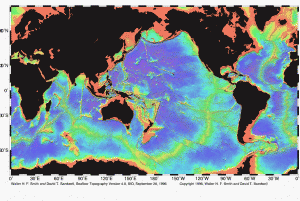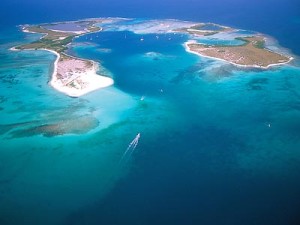The Earth Debate: Part 3
There is a good reason that our “pale blue dot” is blue, and that is because over 70% of the Earth’s surface is covered with water. It is no surprise that life began in the oceans, and water is still essential to life today. On average, a human can survive no longer than 3 days without it. Water is also very useful because it moderates our climate, and it is in this context that it will be discussed in Part 3.
Throughout my travels, I have discovered that the people who are most likely to believe in the urgency of addressing climate change, are those who live in environments which are very sensitive to the effects of the change. For example those who live on the boundaries of climate zones, or near large glaciers – very sensitive to the global temperature. One of these groups is, of course, small island nations who have noticed their territory slowly shrinking as the sea level rises. Older readers of this website may recall a rather terrible Kevin Costner film called Waterworld which was set in a future Earth where the sea level had risen enough to cover almost all of the Earth’s land area. Is such a scenario really possible?
Archimedes’ principle states: Any object, wholly or partly immersed in a fluid, is buoyed up by a force equal to the weight of the fluid displaced by the object.
So, if you have a block of ice floating in some water, when it melts, the water level neither rises nor falls (think about that for a while… I have a funny feeling that that statement is going to generate a few comments). What does this mean in terms of sea-levels though? This means that when arctic sea ice melts, as it has been more and more prone to do lately, the sea level doesn’t change. However, it is important to note that most of the world’s ice isn’t contained in arctic sea ice. The antarctic leads the way, followed by Greenland, then the Andes. All three of these bodies of ice are supported on land. That means that if that ice melts, when it eventually gets to the sea, the sea level will rise.
That all seems very simple, but it isn’t quite the whole story. Water is very heavy. Anyone who has ever lifted a large, full bucket of water will know this (and to those of you who haven’t, the activity comes highly recommended). All matter (“stuff” in layman’s terms) is attracted to all other matter by gravity, but the force is immeasurably small unless the mass of the stuff happens to be very heavy. The Earth is very heavy (it is; have you ever tried lifting it?) and the gravity associated with its mass is what keeps our feet on the ground. All this ice that we keep talking about is also quite heavy. If all of the ice in Antarctica were to melt, that loss of weight would be significant enough to affect the distribution of gravity around the world, enough so that the sea level around Antarctica would actually go DOWN (the mass of all the ice in Antarctica is significant enough to pull the water in the ocean towards it). Elsewhere, where glaciers are melting, the resulting loss of mass on top of the land ends up making the land rise slightly (like a mattress does after you’ve rolled out of bed).
So if the sea level, at least relative to the land, is going DOWN near the poles where all the ice is melting, then where does all this extra water go? The answer is: near the equator. Sadly, it is in tropical areas, where most of the low-lying island nations lie, where sea levels will rise the most.
So rising temperatures will melt the ice and this will raise sea levels. Moreso near the equator than near the poles. I wish that was all there was to it, but there’s more. Anyone who’s thought about how a thermometer works knows that when a liquid is heated, it will expand. The water in the Earth’s oceans is no exception to this rule, and thermal expansion is also contributing to sea level rise.
But wait, there’s more. Remember all that talk about CO2? Well, we’re very lucky that we have so much ocean, because water, like all liquids, can absorb gas. It’s not unlike dissolving sugar into a cup of tea actually. In fact, for a while it was not known why the atmospheric concentration of CO2 was not as high as our output of CO2 would suggest that it should have been. We eventually figured out that the oceans were absorbing a lot of the stuff. Of course, anyone who has tried to add an infinite amount of sugar to a cup of tea knows that you can’t do it forever (believe me, I’ve tried). (Edit: I have assumed that the cup of tea is finite, which I believe to be a reasonable assumption. If you happen to have one of those rare cases of an infinite cup of tea, then it is possible to add an infinite amount of sugar to it. The oceans are likewise assumed to be finite) The same is true of the oceans. As if that wasn’t enough to make you depressed about the world, consider the fact that warmer liquids cannot hold as much gas in solution as colder ones.
So… we release CO2, some of it goes into the ocean and some of it warms the Earth a little bit. As the Earth warms, the oceans lose a bit of their ability to hold CO2, so more CO2 gets released, causing the world to warm a bit more. This is called “positive feedback”, where all the feedback mechanisms reinforce each other. The same sort of thing happens when you put a microphone too close to the speakers… often with similar results – the whole system crashes – something’s gotta give.
The trouble with feedback, is that it sometimes takes a long time for the feedback to make itself known. The amount of carbon in the oceans is affected by the solubility pump, the biological pump, and the carbonate pump. Solubility we’ve already discussed, the biological pump is simply underwater plants photosynthesizing in the same way that land-based plants do. The carbonate pump is shellfish turning carbon into shells. In a cruel twist of fate, many of these shellfish now have much thicker shells as a result of the increased availability of carbon and, as a result, sometimes die because they get trapped inside, or because the shells are too heavy.
A curious side-effect of the carbon chemistry in the oceans is that the oceans are becoming more acidic. This has many bad effects. Coral reefs around the world are already showing signs of literally dissolving away because of the increased acidity. Without these coral reefs, many fish species will die out because they loose their breeding grounds, placing a huge strain on fisheries that are already on the verge of collapse. The increased acidity also speeds up certain types of erosion. The erosion of carbonate rocks may also liberate additional CO2.
So we’re in a bit of a situation. We’ve got CO2 going into the atmosphere which is pushing the thermal equilibrium of the planet toward the warm end of the scale. Moreover, while some of it is being absorbed into the oceans, the warmer temperatures will eventually cause even MORE CO2 to be released from the oceans. Meanwhile, the chemical consequences of the carbon in the oceans is possibly causing more potentially catastrophic cascades of bad stuff to happen – the increased acidity of the oceans, the destruction of coral reefs, the mass extinction of many species of fish.
In Part 4: Population dynamics, Nash equilibrium, and the tragedy of the commons.
Don’t forget to read my other articles in the Earth Debate series.




Nice read to stumble onto. Grazz
~Valerie~